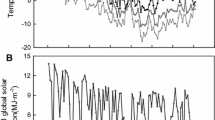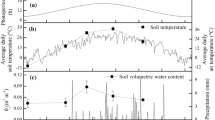Abstract
In the context of the search for future forestry species in Central Europe under climate change scenarios, the evergreen Mediterranean Quercus taxa Q. ilex ssp. ilex and Q. suber and the semideciduous hybrids. Q. × turneri and Q. × hispanica were studied in relation to their photochemical efficiency of photosystem II and to the activity of the xanthophyll cycle under Central European winter conditions. The evergreen taxa were remarkably insensitive to winter stress in the field and reacted towards frost periods with the phenomenon of “chronic photoinhibition”, i.e. a decrease in pre-dawn F v/F m and an increase in the deepoxidation state of the xanthophylls. Under dark and warmer conditions (room temperature), winter-acclimated leaves of the evergreen taxa except for Q. × turneri produced zea- and antheraxanthin and decreased F v/F m, possibly by creation of a chlororespiratory pH-gradient. It is suggested that the ability for dark violaxanthin deepoxidation may contribute to the winter hardiness of the evergreen taxa.








Similar content being viewed by others
Abbreviations
- A:
-
Antheraxanthin
- F o :
-
Ground fluorescence of photosystem II in the dark-adapted state
- F v :
-
Variable chlorophyll fluorescence of photosystem II in the dark-adapted state (=F m − F o)
- F m :
-
Maximum chlorophyll fluorescence of photosystem II in the dark-adapted state
- PS II:
-
Photosystem II
- ROS:
-
Reactive-oxygen species
- RT:
-
Room temperature (i.e. ca. 23–25°C)
- V:
-
Violaxanthin
- VD:
-
V deepoxidase
- Z:
-
Zeaxanthin
References
Adams WW III, Demmig-Adams B, Rosenstiel T, Ebbert V (2001) Dependence of photosynthesis and energy dissipation activity upon growth form and light environment during the winter. Photosynth Res 67:51–62. doi:10.1023/A:1010688528773
Adams WW III, Zarter R, Ebbert V, Demmig-Adams B (2004) Photoprotective strategies of overwintering evergreens. Bioscience 54:41–49. doi:10.1641/0006-3568(2004)054[0041:PSOOE]2.0.CO;2
Anders S, Hoffmann G (1996) Erforschung des ökologischen Wandels—Voraussetzung für künftige Waldbewirtschaftung. In: 9. Hamburger Forst- und Holztagung in Eberswalde. Bundesforstanstalt für Forst- und Holzwirtschaft, Hamburg, pp 129–139
Apel K, Hirt H (2004) Reactive oxygen species: metabolism, oxidative stress, and signal transduction. Annu Rev Plant Biol 55:373–399. doi:10.1146/annurev.arplant.55.031903.141701
Aranda I, Castro L, Alia R, Pardos JA, Gil L (2005) Low temperatures during winter elicits differential responses among populations of the Mediterranean evergreen cork oak (Quercus suber). Tree Physiol 25:1085–1090
Asada K (2006) Production and scavenging of reactive oxygen species in chloroplasts and their function. Plant Physiol 141:391–396. doi:10.1104/pp.106.082040
Both H, Brüggemann W (2009) Photosynthesis studies on European evergreen and deciduous oaks grown under Central European climate conditions. I. A case study of leaf development and seasonal variation of photosynthetic capacity in Quercus robur (L.), Q. ilex (L.) and its semideciduous hybrid, Q × turneri (Willd.). Trees (Berl) (in press)
Casano LM, Martin M, Sabater B (2001) Hydrogen peroxide mediates the induction of chloroplastic Ndh complex under photoxidative stress in Barley. Plant Physiol 125:1450–1458
Corcuera L, Morales F, Abadia A, Gil-Pelegrin E (2005a) Seasonal changes in photosynthesis and photoprotection in a Quercus ilex subsp. ballota woodland located in its upper altitudinal extreme in the Iberian peninsula. Tree Physiol 25:599–608
Corcuera L, Morales F, Abadia A, Gil-Pelegrin E (2005b) The effect of low temperatures on the photosynthetic apparatus of Quercus ilex subsp. ballota at its upper altitudinal limits in the Iberian peninsula and during a single freezing-thawing cycle. Trees 19:99–108
Cristofolini G, Crema S (2005) A morphometric study of the Quercus crenata species complex (Fagaceae). Bot Helv 115:155–167
Färber A, Jahns P (1998) The xanthophyll cycle of higher plants: influence of antenna size and membrane organization. Biochim Biophys Acta Bioenergetics 1363:47–58
Fernandez-Marin B, Balaguer L, Manrique E, Gomez-Fernandez P, Esteban R, Becerril JM, Garcia-Plazaola JI (2008) Dark induction of xanthophyll cycle mediated by desiccation (Poster contribution to the 2008 FESPB congress in Tampere, Finland). Physiol Plant 133(Suppl):P09–042
Haußühl K, Andersson B, Adamska I (2001) A chloroplast DegP2 protease performs the primary cleavage of the photodamaged D1 protein in plant photosystem II. EMBO J 20:713–722
Himrane H, Camarero JJ, Gil-Pelegrin E (2004) Morphological and ecophysiological variation of the hybrid oak Quercus subpyrenaica (Q. faginea × Q. pubescens). Trees 18:566–575
Ivanov AG, Sane PV, Zeinalov Y, Malmberg G, Gardeström P, Huner NPA, Öquist G (2001) Photosynthetic electron transport adjustments in overwintering Scots pine (Pinus sylvestris L.). Planta 213:575–585
Jakob T (2002) Auswirkungen chlororespiratorischer Aktivität auf den Xanthophyllzyklus der Diatomee Phaeodactylum tricornutum. PhD Thesis, University of Leipzig
Jakob T, Goss R, Wilhelm C (1999) Activation of diadinoxanthin de-epoxidase due to a chlororespiratory proton gradient in the dark in the diatom Phaeodactylum tricornutum. Plant Biol 1999:76–82
Koroleva OY, Brüggemann W, Krause GH (1994) Photoinhibition, xanthophyll cycle and in vivo chlorophyll fluorescence quenching of chilling-tolerant Oxyria digyna and chilling-sensitive Zea mays. Physiol Plant 92:577–584
Logullo MA, Salleo S (1993) Different vulnerabilities of Quercus ilex L. to freeze-induced and summer drought-induced xylem embolism: an ecological interpretation. Plant Cell Environ 16:511–519
Long SP, Humphries S, Falkowski PG (1994) Photoinhibition of photosynthesis in nature. Annu Rev Plant Physiol Plant Mol Biol 45:633–662
Lucht W, Schaphoff S, Erbrecht T, Heyder U, Cramer W (2006) Terrestrial vegetation redistribution and carbon balance under climate change. Carbon Balance Manage 1:6
Martínez-Ferri E, Manrique E, Valladares F, Balaguer L (2004) Winter photoinhibition in the field involves different processes in four co-occuring Mediterranean tree species. Tree Physiol 24:981–990
Morecroft MD, Stokes VJ, Morison JIL (2003) Seasonal changes in the photosynthetic capacity of canopy oak (Quercus robur) leaves: the impact of slow development on annual carbon uptake. Int J Biometeorol 47:221–226
Nardini A, Ghirardelli L, Salleo S (1998) Vulnerability to freeze stress of seedlings of Quercus ilex L.: an ecological interpretation. Ann Sci For 55:553–565
Nardini A, Salleo S, Lo Gullo MA, Pitt F (2000) Different responses to drought and freeze stress of Quercus ilex growing along a latitudinal gradient. Plant Ecol 148:139–147
Öquist G, Huner NPA (2003) Photosynthesis of overwintering evergreen plants. Annu Rev Plant Biol 54:329–355
Ottander C, Campbell D, Öquist G (1995) Seasonal changes in photosystem II organisation and pigment composition in Pinus sylvestris. Planta 197:176–183
Peltier G, Cournac L (2002) Chlororespiration. Annu Rev Plant Biol 53:523–550
Ruelland E, Miginiac-Maslow M (1999) Regulation of chloroplast enzyme activities by thioredoxins: activation or relief from inhibition? TIPS 4:136–141
Schär C, Vidale P, Lüthi D, Frei C, Häberli C, Liniger MA, Appenzeller C (2004) The role of increasing temperature variability in European summer heatwaves. Nature 427:332–335
Schnettger B, Leitsch J, Krause GH (1992) Photoinhibition of photosystem 2 in vivo occurring without net D1 protein degradation. Photosynthetica 27:261–265
Streb P, Josse EM, Gallouet E, Baptist F, Kuntz M, Cornic G (2005) Evidence for alternative electron sinks in the photosynthetic carbon assimilation ion the high mountain plant species Ranunculus glacialis. Plant Cell Environ 28:1123–1135
Thiele A, Schirwitz K, Winter K, Krause GH (1996) Increased xanthophyll cycle activity and reduced D1 protein inactivation related to photoinhibition in two plant systems acclimated to excess light. Plant Sci 115:237–250
Tyree MT, Cochard H (1996) Summer and winter embolism in oak: impact on water relations. Ann Sci For 53:173–180
Wiltshire E (2004) The Fulham oak in London. London Naturalist 83:29–31
Wiltshire E, Coombes AJ (2001) Quercus × turneri Willd.: a rare London hybrid oak. London Naturalist 80:21–27
Acknowledgments
Thanks are due to the Palmengarten of the City of Frankfurt (Dr. C. Bayer) for giving access to the hybrid specimens and to Mrs. R. Caps and U. Feickert for excellent technical assistance with the HPLC analysis. The present study was in part financially supported by the research funding programme “LOEWE-Landes-Offensive zur Entwicklung Wissenschaftlich-ökonomischer Exzellenz” of Hesse′s Ministry of Higher Education, Research and the Arts through the Biodiversity and Climate Research Centre, Frankfurt.
Author information
Authors and Affiliations
Corresponding author
Additional information
Communicated by W. Bilger.
Rights and permissions
About this article
Cite this article
Brüggemann, W., Bergmann, M., Nierbauer, KU. et al. Photosynthesis studies on European evergreen and deciduous oaks grown under Central European climate conditions: II. Photoinhibitory and light-independent violaxanthin deepoxidation and downregulation of photosystem II in evergreen, winter-acclimated European Quercus taxa. Trees 23, 1091–1100 (2009). https://doi.org/10.1007/s00468-009-0351-y
Received:
Revised:
Accepted:
Published:
Issue Date:
DOI: https://doi.org/10.1007/s00468-009-0351-y




